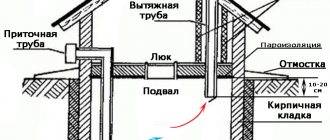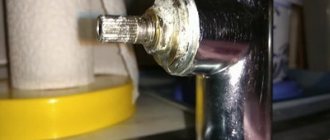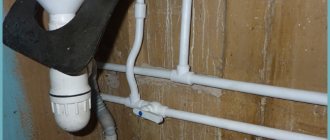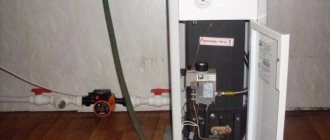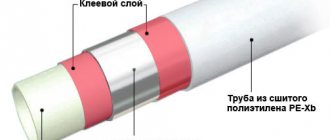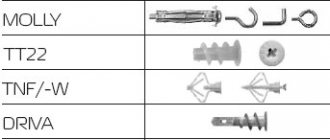Effective and long-term operation of the sewer system directly depends on timely cleaning of sewer pipes. But if an unpleasant situation has already happened, that is, the pipe is clogged, it will be noticeable immediately: the water will slowly flow into the sewer hole. Clogged pipes can lead to bad consequences, even to the point that wastewater flows back into the apartment or house. And on top of that, the home will be saturated with an unpleasant odor. Therefore, it is imperative to clean the pipes on time and get rid of blockages in the sewer system as soon as possible; these works will bring comfort and coziness to any home.
- 2 Household products for removing blockages
- 3 Chemicals in the fight against blockages
- 4 Using a plunger
- 5 Cleaning sewer pipes using a cable
- 6 Comparison of the cost of different cleaning methods
Causes of clogged sewer pipes
First of all, you need to understand what a clog in sewer pipes is and what is an effective way to eliminate it. Over time, organic and inorganic deposits can form on the pipe walls. Since the inner surface of the pipe is subject to mechanical damage, scratches may appear on it. They slow down the flow of wastewater, and they can also trap garbage.
Due to plaque and
accumulated waste, the internal diametrical size of the pipe is greatly reduced. It can become smaller by even 2 cm, which leads to a decrease in efficiency and disruptions in the sewerage workflow.
Therefore, timely cleaning of sewer pipes is necessary. A mechanical blockage is an accumulation of debris that occurs due to the accidental entry of a foreign object into the pipe. Clogs can come from used toilet paper, sanitary pads, paper waste and other household waste that is flushed down the drain in the belief that it will flow unimpeded throughout the sewer system.
A technological blockage is a blockage of horizontal sections of a pipeline, with a small slope of sewer pipes or with a counter-slope. To avoid such a blockage, it is necessary to install the sewer system taking into account all technical requirements, because horizontal sections and places where pipes with a smaller diameter operate are the main problem areas in the sewer system.
The causes of blockages can be different, and according to this, there are various ways to eliminate them:
- Mechanical removal using a plunger or plumbing cable.
- Using chemicals.
- Thermal heating of the suspected blockage site.
- Flushing the blockage using a hydrodynamic method under pressure.
Purifying water from lime using traditional methods
If people do not live in a country house all year round, then you can get rid of impurities in the well using simpler methods. Large particles (sand, clay, iron) can be easily removed with household “jugs”. The filter mesh of devices cannot cope with lime, so proven traditional methods are used for potassium salts.
Advocacy
Purify water by settling.
The simplest option that will help you get fresh, clean water. Liquid is collected into a bucket and left overnight to filter. Harmful impurities from the well settle at the bottom of the container. Carefully drain 2/3 of the moisture into another bowl, trying not to disturb the bottom layer.
The simple method does not require a person to have professional equipment or reagents. For the domestic needs of a large family, large tanks will be needed to collect and settle liquids.
To facilitate draining from a large tank, you need to purchase a special pump for transferring. The deposited sediment is regularly washed off the surface of the dishes.
Boiling
During thermal treatment of water, lime accumulates in the form of scale on the inner walls of containers. Boiling for 15 minutes kills bacteria and impurities precipitate. A lot of liquid cannot be cleared this way. The difficulties of removing a thick layer on the walls and the cost of electricity offset the benefits of the method. To clean a large volume, you will have to purchase large dishes or heat them more often.
To facilitate boiling, it is necessary to pre-filter the water from the well. Simple units mechanically collect particles larger than 5 µg. Sand from quartz chips and shungite are used as backfill in devices. Each component has a reserved capacity, after which the composition must be changed.
Freezing
Fill an enamel pan with water and place the dishes in an empty freezer. After a few hours, half of the moisture freezes. Impurities and dirt accumulate in the center of the ice. If you pour boiling water on top, the dangerous additives can be easily removed. For drinking and cooking, liquid from the hardened piece is used.
Method of water purification by freezing.
The disadvantage of this method is the low cleaning speed. If you don’t have a large freezer, the process takes a long time. Purified water has characteristics similar to distilled water and does not contain useful microelements.
The substance cannot be consumed regularly or must be additionally mineralized. There are many dangerous components in the remaining liquid from the pan.
Activated carbon cleaning
In the production of household filters, activated carbon is used as a sorbent. At home, a pharmaceutical preparation will help remove foreign odors and impurities from hard water. 5 tablets are wrapped in a piece of clean gauze and placed in a container with liquid for 12 hours. In the morning, carefully remove the bag with the remaining component, being careful not to spill the black substance.
Lime in a well is a dangerous element that negatively affects human health and the operation of household appliances. Filtration will help rid the water of all foreign impurities and improve its taste. Popular methods of purifying moisture in a country house can be combined to achieve maximum results.
Household products for removing blockages
The appearance of blockages does not please anyone, because it is impossible to predict its occurrence in advance. But it is still possible to somewhat delay its occurrence. For example, using special screens on a kitchen or bathroom sink will prevent foreign objects from getting into the drain hole.
When a blockage occurs, it is difficult to determine the level of complexity by eye, so you need to start eliminating it with simple methods. If you can’t remove the blockage yourself, you can try more complex and expensive methods.
You can try to get rid of the blockage using boiling water or just hot water. To do this, you need to open the hot water tap and leave it for a few minutes, making sure that the water does not spill over the edges of the sink and cause a flood.
If the blockage is small and is mainly caused by fatty deposits , then this cleaning method will be effective, as the pipe will be cleared. You can simply boil the kettle and pour it into the drain hole.
If you have plastic sewer pipes, it is not recommended to use concentrated solutions of caustic substances to clear blockages. You can remove fat deposits and small particles of debris using vinegar and soda. This is done like this:
- 1 cup of soda should be poured into the drain hole;
- then you need to pour vinegar in the same amount;
- it is necessary to withstand a certain time: approximately 30-40 minutes for the substances to react;
- Use a generous stream of hot water to rinse off the available means used to remove the blockage.
Signs of deposits
Rusty water and low pressure are the first signs of a problem.
Rust deposits change the color and taste of the water. The liquid becomes reddish, and an iron taste appears. Sediments with a mineral or biological structure also cause turbidity in the stream. The main sign of plaque formation is a decrease in water pressure. Apartment residents should ask their neighbors about the status of their water supply. If the rest of the system is working properly, there is a blockage in the line section.
Disadvantages of overgrown water pipes:
- pressure and estimated water consumption are reduced;
- a suspension of small particles appears in the water;
- the surface of the highway is destroyed;
- Chlorine quickly disappears, the degree of disinfection decreases;
- the operation of the shut-off valves is disrupted.
If there is significant sediment formation in the old main, it is best to replace the pipes. After long use, their surface is severely damaged by corrosion, deposits will appear very quickly. In new water supply systems, it is enough to clean the cold water pipe in the apartment without replacing it.
Chemicals to combat blockages
For cleaning pipes, such products are simple and inexpensive. They are divided according to their composition into acidic and alkaline.
Chemicals can be:
- Granular.
- Gel-like.
- In powder form.
- In the form of a liquid.
There is no need to use a chemical if the drain pipe is completely clogged, as the chemicals can leak out and damage the bathtub or sink.
The gel-like chemical is a viscous substance. It acts on fatty deposits in pipes for a longer period of time; even after washing with water, the chemical process continues, since the gel has already penetrated deeply into the deposit. Substances in the form of a gel for removing blockages are not as dangerous as granular products, but they are more effective.
Liquid products for clearing blockages must be used strictly according to the instructions, as they can damage rubber gaskets or plastic pipes. But they can be called leaders in sewer cleaning; they work very effectively.
Powder and granular products are the most concentrated of the above chemical products. It is necessary to pour a certain amount of granules or powder into the drain hole, and after a while pour hot water to start the reaction. The entire process of clearing blockages must be carried out with rubber gloves, since the granular product poses a danger to the skin due to its high chemical activity. This remedy is the most advantageous compared to the above substances.
The main advantages of the granular product:
- does not harm plastic pipes;
- does not react with metal pipes;
- perfectly dissolves hair - one of the main causes of blockages in sewer pipelines;
- even removes lime deposits.
The most popular chemical agent is "Mole" . It has been used for quite a long time and has proven itself to be excellent. It can be used not only for cleaning pipes and for preventive purposes.
Using chemicals to remove blockages solves the problem of blockages, but also disinfects sewer pipes, since their use removes bacteria and, along with them, an unpleasant odor.
Preventive measures
Preventing a problem from occurring is always cheaper than fixing it. And the point is not that the house may be old. New buildings are connected to the same worn-out utility system, and one cannot expect that the quality of water for residents of a new multi-apartment building will be better.
Through pipes laid near sewers, garbage migrates to residents, being suspended in water and picked up by pressure. But if previously there were pipes with a large diameter along the way, then this “garbage” can form a blockage in the wiring, even if it was laid recently. The new pipeline does not reduce the danger, since no filters are installed at the entrance to the house (riser).
It is the coarse filtration station that will completely solve the problem. The filter must be installed at the inlet before the “dirt” enters the meter. The only element that can stand in front is the shut-off valve. This is necessary for filter maintenance, which consists of periodically cleaning the screens or replacing filters. If this is done in a timely manner, the risk of blockage will be negligible.
Separately, it should be noted that the introduction of preventive measures contributes not only to this. It is enough to install a filter, and the service life of the pipeline will be increased. How much? This depends on the efficiency with the number of degrees of purification. Ideally, the water will be purified from bacteria, scale, solid inclusions, chemical contaminants, and harmful impurities. No build-up will form.
Using a plunger
If it was not possible to clear the blockage using simple methods, you can move on to more complex ones - using a plunger, for example. The plunger consists of a rubber cap and a wooden handle.
Using a plunger to clean pipes does not require special knowledge or skills. To clean a countertop sink in the bathroom or a ceramic sink in the kitchen, you need to:
- Close the drain hole with the rubber part of the plunger.
- Turn on hot water.
- When the water hides the rubber cap of the plunger, you need to give it a few very vigorous pumps. This process creates pressure differences in the drain that help break down the plug that created the blockage.
- Pull out the plunger; if successful, the water will form a funnel and quickly flow into the cleaned drain.
Reverse osmosis purification
If the well has hard water, then reverse osmosis is used. The liquid is forced through a fine membrane. Harmful impurities and sand remain on the surface of the layer of semi-permeable raw materials. The device allows oxygen and moisture to pass through, but retains mechanical particles. Depending on the model, the device cleans from 170 to 250 liters per day.
A complex filter system consists of:
- pre-cleaning devices;
- pump;
- control and measuring instruments;
- flushing block.
Activated carbon is used as the main sorbent. To improve the characteristics of water, additional cartridges are installed in the device. A special mineralizer enriches the liquid with useful substances, and the ionizer suppresses bacterial activity. At home, it is possible to purify water from lime by 95%.
The only drawback is the frequent replacement of filter components and the high price of consumables. The capacity of the standard system is 5000 l. For drinking and cooking, a family of 4 uses at least 4000 liters. If you use a washing machine or dishwasher in a country house, you will have to change the cartridges every 3 weeks.
Reverse osmosis water purification scheme.
Cleaning sewer pipes using a cable
Using a plumbing cable, you can clear even a complex blockage in the sewer.
When the plunger fails, a plumbing cable comes to the rescue. The cable is a steel wire twisted into a spiral, one end of which is equipped with a handle, and the other has the shape of a drill. The length of the cable is about 3 meters, and the thickness varies.
User manual:
- The cable is inserted into the drain hole and directed in a circular motion forward towards the suspected blockage.
- When the cable is twisted or screwed in, it moves forward, smoothly bypassing all joints and bends of the sewer pipes.
- When the cable has reached the blockage (this will be felt immediately), it is necessary to make several back-and-forth movements to push the blockage plug. After this, the cable must be pulled out and cleaned. If necessary, it is advisable to repeat the procedure. It is important to remember that the diametrical size of the cable must be smaller than the diameter of the pipe.
- Then the pipes must be washed with high pressure of hot water. Rinse the cable, dry it, roll it into a ring and put it in storage.
Ultrafiltration method
The flow filter for limewater from a well is equipped with a special lamp. The liquid passes through a membrane that retains existing impurities . The small size of the membrane cells (up to 0.1 microns) allows you to catch not only debris, but also pathogenic microorganisms. The device captures mineral additives at the ionic and molecular levels.
Porous filters are made from cellulose derivatives. The material is sensitive to acids and alkalis, and therefore effectively copes with the purification of water of any degree of hardness. With high performance, the device consumes little electricity. At the exit, the liquid becomes soft and contains useful microelements.
Ultrafiltration equipment is used to clarify water. Ease of operation and economical consumption of reagents helps reduce the cost of obtaining clean liquid. Standard modules provide a higher degree of disinfection than ozonation or chlorination. The fine mesh membrane does not allow viruses and bacteria to pass through.
Scheme of the ultrafiltration water purification method.
Ultrafiltration has disadvantages:
- High price of the technique.
- Specific installation. Installation requires complex technical devices.
- Helium sediment. A layer forms on the surface of the filter, which makes cleaning difficult.
Ultrafiltration is often used as an additional step before reverse osmosis equipment and ion exchange filters.
The device clarifies cloudy water, and coagulants are used to combat lime. The technique removes more than 95% of colloids and organic matter, preventing membrane clogging.
Prevention
How to avoid sewer blockages?
Alas, instead of blurting out professional secrets, I will have to repeat a few common truths.
- Use the toilet only for its intended purpose. A trash can should be used for disposal of garbage and food waste;
- When draining water from a bucket or basin after washing floors or windows, check to see if there is a rag in it;
- Install nets on the outlets of sinks and bathtubs;
The mesh will prevent hair and other debris from getting into the drain.
- Use hot water to wash dishes. My personal statistics confirm that the peak in the number of local blockages occurs in the summer, when the hot water temperature drops to 40 - 45 degrees. In winter, warmer water does a great job of washing away fat.
Composition of solvents for concrete
Concrete and cement removers contain acids, surfactants and other additives. They should start an oxidation reaction. Thanks to this, the composition penetrates into the pores of concrete and destroys it. When the reaction is complete, the dirt is simply wiped off with a rag, napkin or washed away with water.
The basis of any remover for removing cement and concrete is hydrochloric, acetic, lactic or some other acid. To prevent it from interacting with metal, wood, and tiles, various additives are added to the composition. Therefore, concrete solvents can be used on plastic, wood, metal, and ceramic surfaces.
Pumping and disposal of fat from grease traps
A grease trap, just like a sewer, requires regular maintenance.
Catering enterprises, as well as food production enterprises such as meat processing plants, dairy plants, fat-and-oil plants and the like have a high concentration of fats in their wastewater. Insufficient wastewater treatment leads to the formation of fatty deposits on sewer pipes. To avoid emergency situations, such enterprises are required to be equipped with grease traps. This design helps filter out the grease, after which it enters a chamber where it is stored until it is removed.
A grease trap, just like a sewer, requires regular maintenance, in the absence of which there is an increased risk that the water will simply stop going down the drain, which will make the facility impossible to operate. Sanitary control services may impose penalties for this.
Pumping out and disposal of fat is impossible without the necessary license and documentation. Ecolife Group of Companies offers a wide range of services, including cleaning grease traps and disposal of fat deposits.
Top of page
Order flushing
Cleaning of pipes on an industrial scale (flushing pipelines of apartment buildings, industrial buildings, heating and cooling systems in factories, etc.) must be carried out by qualified teams using special cleaning liquids, for example, “SP-OM” brand.
Liquid for washing and cleaning: SP-OM
These compositions have proven themselves well in breweries and wineries, as well as in the food production of drinks and juices. You can purchase products and order cleaning on the manufacturer’s website https://www.splast.ru/ochistka-i-promyvka/

